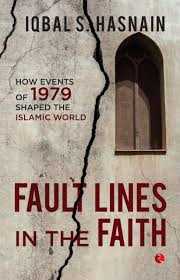
In his compelling book Fault Lines in the Faith: How Events of 1979 Shaped the Islamic World, scholar Iqbal S. Hasnain pinpoints one transformative year and two deep-rooted fault lines that continue to influence the political and religious trajectory of Muslim societies today.
The year 1979 witnessed three seismic events: the Islamic Revolution in Iran, the extremist siege of the Kaaba in Makkah by Juhayman al-Otaybi’s cult, and the Soviet invasion of Afghanistan. These events, Hasnain argues, sent lasting shockwaves through the Islamic world. Each had historical roots but evolved into defining moments that reshaped geopolitics and religious identities.
The Iranian revolution brought down the US-backed monarchy and ushered in a populist Shia theocracy under Ayatollah Khomeini, sparking anxieties in the Sunni Arab world. The Saudi regime, already anchored in Wahhabism—a puritanical Salafist ideology—doubled down on religious orthodoxy in response to the Makkah crisis, leading to decades of ultra-conservative export funded by petrodollars.
Meanwhile, the Soviet-Afghan war became the crucible in which the US, Saudi Arabia, and Pakistan collaborated to arm and radicalize Islamist fighters, laying the groundwork for Al Qaeda, Osama bin Laden, and eventually ISIS.
Hasnain identifies two fault lines driving modern Islamic extremism: the Sunni-Shia divide, and the clash between hardline Salafism and spiritually inclined Sufism. He traces the ideological and material spread of Wahhabism, funded and legitimized by the Saudi state and, wittingly or not, enabled by the United States.
While praising recent reformist moves by Saudi Crown Prince Mohammed bin Salman, Hasnain stresses the continued threat of Wahhabi ideology to global peace and intra-Muslim harmony. His call for a revival of Sufi values—compassion, inclusiveness, and spiritual depth—as a counter to extremism is both timely and necessary.
Yet the book stops short of exploring why the US continues to ignore the ideological roots of extremism within its closest Middle Eastern ally. This, the reviewer argues, is not a blind spot but a strategic choice: US foreign policy tends to favor elite-controlled regimes—be they monarchies or military dictatorships—over grassroots populist movements, whether religious or secular. The preference for pliable partners aligns with American corporate and geopolitical interests, making the support for Saudi Arabia a pragmatic, albeit morally compromised, constant.
Hasnain’s book is a significant contribution to understanding the modern Islamic world’s ideological turmoil and geopolitical entanglements. Though occasionally repetitive, it offers a clear diagnosis of the enduring crises that began in 1979—and a prescription rooted in the spiritual traditions of Islam itself.
In his compelling book Fault Lines in the Faith: How Events of 1979 Shaped the Islamic World, scholar Iqbal S. Hasnain pinpoints one transformative year and two deep-rooted fault lines that continue to influence the political and religious trajectory of Muslim societies today.
The year 1979 witnessed three seismic events: the Islamic Revolution in Iran, the extremist siege of the Kaaba in Makkah by Juhayman al-Otaybi’s cult, and the Soviet invasion of Afghanistan. These events, Hasnain argues, sent lasting shockwaves through the Islamic world. Each had historical roots but evolved into defining moments that reshaped geopolitics and religious identities.
The Iranian revolution brought down the US-backed monarchy and ushered in a populist Shia theocracy under Ayatollah Khomeini, sparking anxieties in the Sunni Arab world. The Saudi regime, already anchored in Wahhabism—a puritanical Salafist ideology—doubled down on religious orthodoxy in response to the Makkah crisis, leading to decades of ultra-conservative export funded by petrodollars.
Meanwhile, the Soviet-Afghan war became the crucible in which the US, Saudi Arabia, and Pakistan collaborated to arm and radicalize Islamist fighters, laying the groundwork for Al Qaeda, Osama bin Laden, and eventually ISIS.
Hasnain identifies two fault lines driving modern Islamic extremism: the Sunni-Shia divide, and the clash between hardline Salafism and spiritually inclined Sufism. He traces the ideological and material spread of Wahhabism, funded and legitimized by the Saudi state and, wittingly or not, enabled by the United States.
While praising recent reformist moves by Saudi Crown Prince Mohammed bin Salman, Hasnain stresses the continued threat of Wahhabi ideology to global peace and intra-Muslim harmony. His call for a revival of Sufi values—compassion, inclusiveness, and spiritual depth—as a counter to extremism is both timely and necessary.
Yet the book stops short of exploring why the US continues to ignore the ideological roots of extremism within its closest Middle Eastern ally. This, the reviewer argues, is not a blind spot but a strategic choice: US foreign policy tends to favor elite-controlled regimes—be they monarchies or military dictatorships—over grassroots populist movements, whether religious or secular. The preference for pliable partners aligns with American corporate and geopolitical interests, making the support for Saudi Arabia a pragmatic, albeit morally compromised, constant.
Hasnain’s book is a significant contribution to understanding the modern Islamic world’s ideological turmoil and geopolitical entanglements. Though occasionally repetitive, it offers a clear diagnosis of the enduring crises that began in 1979—and a prescription rooted in the spiritual traditions of Islam itself.
© Copyright 2023 brighterkashmir.com All Rights Reserved. Quantum Technologies